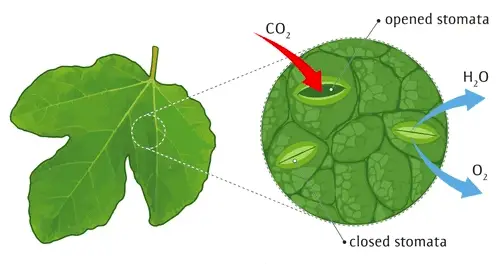Plants take in carbon dioxide and release oxygen gas as part of photosynthesis. The process by which they do this is fascinating, and scientists are still working to understand all the intricacies involved.
In this blog post, we will explore where carbon dioxide enters the plant and how it is transported throughout the organism. We will also discuss what happens to the carbon dioxide once it is inside the plant. Stay tuned for an interesting look at one of nature’s most important processes!
Where Does Carbon Dioxide Enter the Plant?
Carbon dioxide enters the plant through tiny pores called stomata (singular: stoma). Stomata are found on the leaves and other parts of the plant that are exposed to the air. Each stoma is surrounded by two guard cells.
When the guard cells take in water, they swell and cause the stoma to open. This allows carbon dioxide and other gases to enter the plant. The stoma will close when the guard cells lose water.
The stomata are important for gas exchange, but they also help regulate water loss from the plant. By opening and closing, as needed, the stomata can help the plant conserve water on hot days or when the soil is dry.

What Happens to Carbon Dioxide Once It’s Inside the Plant?
Once carbon dioxide enters the plant, it diffuses throughout the cells. The process of diffusion is how molecules move from an area of high concentration to an area of low concentration.
So, in this case, the carbon dioxide molecules will spread out from the stoma until they are evenly distributed throughout the plant cells.
From there, the carbon dioxide molecules are used in photosynthesis to make glucose (sugar). The plant uses glucose for energy and to build other molecules that it needs to grow and survive.
The leftover oxygen gas is released back into the atmosphere through the stomata. And so the cycle begins anew!
Where Does Carbon Dioxide Enter a Tree?
Just like with plants, carbon dioxide enters a tree through tiny pores called stomata. Stomata are found on the leaves and other parts of the tree that are exposed to the air. Each stoma is surrounded by two guard cells.
By taking in carbon dioxide, the tree can use the process of photosynthesis to make its own food! The only other requirements are water (from the roots) and sunlight (from the leaves).
Conclusion
In conclusion, plants take in carbon dioxide and release oxygen gas as part of photosynthesis. The process by which they do this is fascinating, and scientists are still working to understand all the intricacies involved.
In this blog post, we explored where carbon dioxide enters the plant and how it is transported throughout the organism. We also discussed what happens to carbon dioxide once it is inside the plant.
If you have any questions or comments, please let us know! We hope you enjoyed this quick exploration of carbon dioxide and plants. Stay tuned for more posts on photosynthesis and other plant processes. Thanks for reading!
Tim is an avid gardener from the UK. He was the founder of PlantCarer.com from 2021 to Sep 2023. He sold PlantCarer.com to Aaron. He has since started his own business called Seed To Supper, which provides new gardeners all the materials you need in a box (pots, seeds, compost and instructions) to grow your own delicious and nutritious vegetables and herbs from start to finish – no garden required.









0 Comments